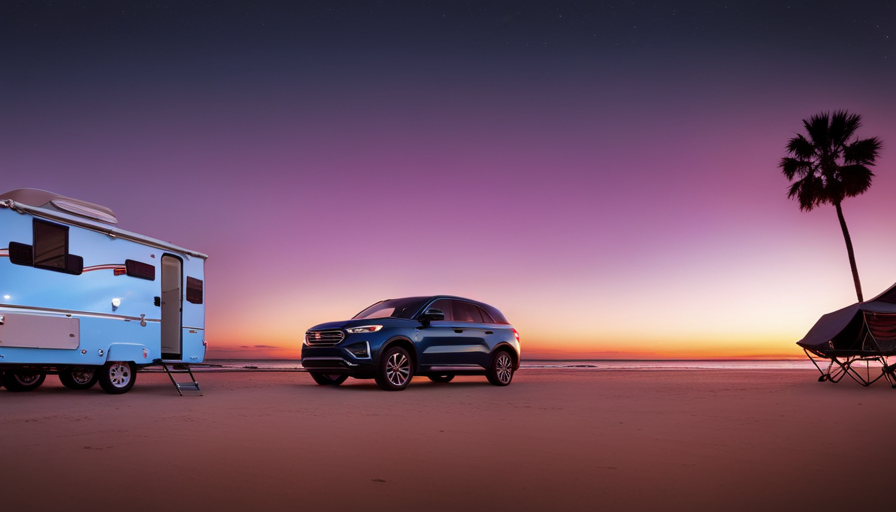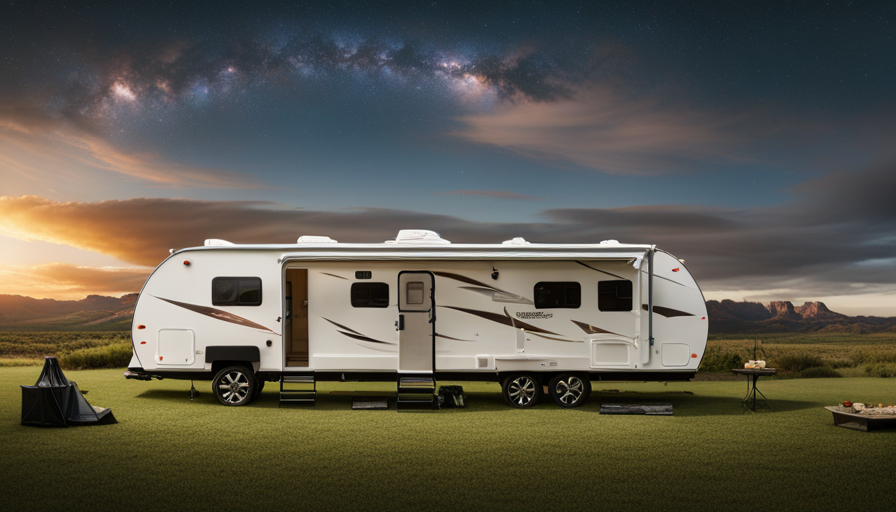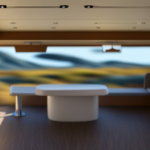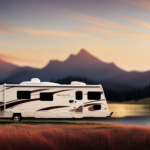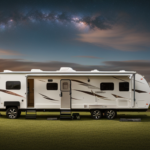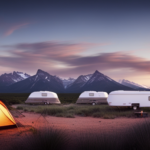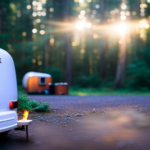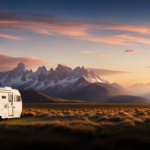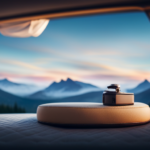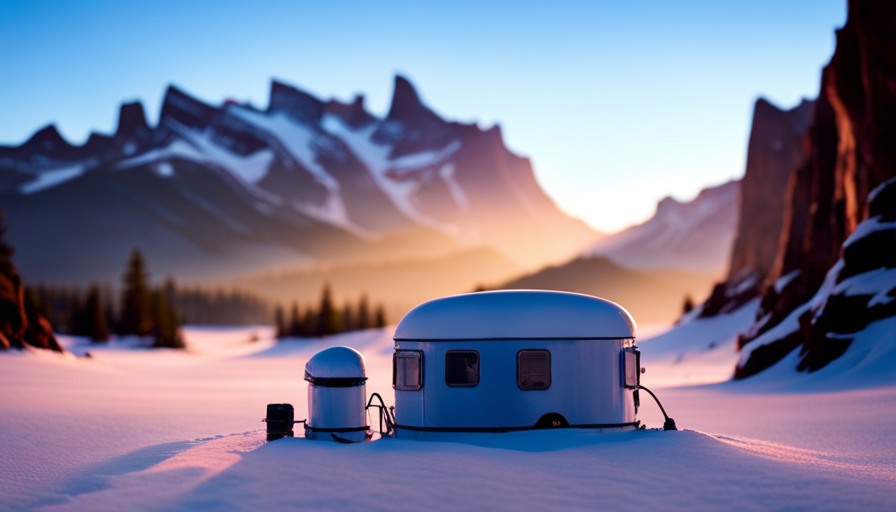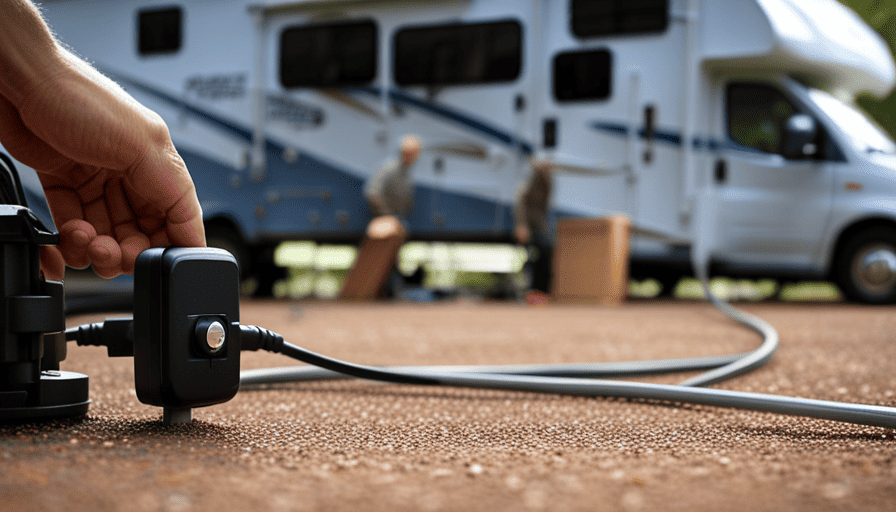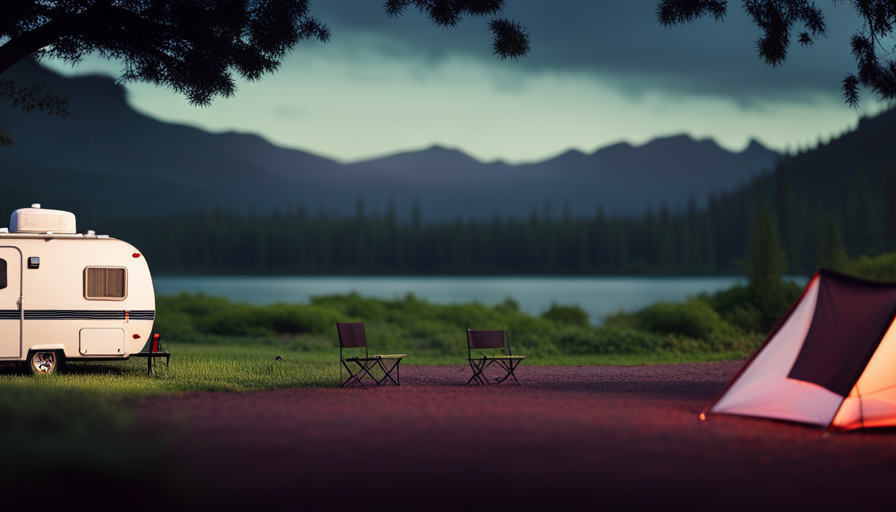How wide is a pop-up camper?
It’s a question that many outdoor enthusiasts ask when considering the dimensions of their camping rig. In this article, we will explore the various factors that affect the width of pop up campers, as well as the benefits of choosing a narrower option.
We will also discuss important considerations for finding the perfect width for your needs, and provide maintenance and care tips for a narrow pop up camper. Additionally, we will delve into pop up camper width regulations and restrictions, ensuring that you stay compliant on the road.
Finally, we will highlight popular brands and models with different widths, giving you a range of options to choose from. So, whether you’re a seasoned camper or a beginner, join us as we delve into the world of pop up campers and discover the perfect width for your outdoor adventures.
Key Takeaways
- Pop-up campers typically range in width from 6 to 8 feet, with the most common width being 7 to 8 feet.
- The width of a pop-up camper is influenced by factors such as the type of trailer, number of beds, desired interior layout, and inclusion of a kitchen and bathroom.
- A narrower pop-up camper is easier to tow and maneuver on the road, making it a better fit for smaller vehicles and enhancing fuel efficiency.
- The width of a pop-up camper affects storage space, layout configurations, and overall maneuverability, so personal camping needs and preferences should be considered when choosing the right width.
Understanding the Dimensions of a Pop Up Camper
A pop-up camper is typically about 7 to 8 feet wide, providing enough space for a comfortable camping experience. The dimensions of a pop-up camper are influenced by various factors, such as the type of trailer, the number of beds, and the desired interior layout. These factors play a crucial role in determining the width of the camper.
One of the key considerations when designing the dimensions of a pop-up camper is the importance of the interior layout. Manufacturers carefully plan the arrangement of furniture, appliances, and amenities to maximize space utilization. This ensures that campers have enough room to move around and store their belongings.
Additionally, the width of a pop-up camper is influenced by factors such as the size of the beds and the number of sleeping areas. Campers with larger beds may require a wider trailer to accommodate them. Similarly, if the camper has multiple sleeping areas, it will need to be wider to provide sufficient space for each section.
Understanding the factors affecting the width of pop-up campers is essential for selecting the right size for your camping needs. By considering the interior layout and the number of beds required, you can ensure a comfortable and enjoyable camping experience.
Factors Affecting the Width of Pop Up Campers
When you step inside a pop-up camper, it’s like entering a cozy cabin on wheels, where every inch of space is carefully designed to maximize comfort and functionality. The width of a pop-up camper can vary depending on several factors that affect its overall dimensions. Understanding these factors is crucial when considering the perfect pop-up camper for your personal camping preferences.
Factors Affecting Width:
-
Slide-out Features: Some pop-up campers have slide-out sections that expand the living space, increasing the overall width when extended.
-
Sleeping Arrangements: The number and size of beds inside the camper can affect its width. Larger beds may require more space, while smaller ones can save on width.
-
Kitchen and Bathroom Facilities: The inclusion of a kitchen and bathroom can impact the width of a pop-up camper. These amenities may require additional space, thus affecting the overall width.
-
Storage Options: The presence of storage compartments also takes up space and can contribute to the overall width of the camper.
-
Exterior Features: Features like awnings, bike racks, or propane tanks mounted on the exterior can affect the width of a pop-up camper.
Considering these factors, it’s important to assess your personal camping preferences and prioritize the features and width that best suit your needs. In the next section, we will explore the common width ranges for pop-up campers.
Common Width Ranges for Pop Up Campers
To find the perfect pop-up camper for your camping adventures, you’ll want to know the common width ranges available. Understanding the dimensions of a pop-up camper is crucial in ensuring vehicle compatibility and a comfortable camping experience.
Pop-up campers typically come in two width ranges: 6 to 7 feet and 7 to 8 feet. The narrower width range of 6 to 7 feet is more common and offers several benefits.
A narrower pop-up camper is generally easier to tow and maneuver on the road. It’s also more likely to fit in tight spaces, such as narrow campsite entrances or narrow roads in campground areas. Additionally, a narrower camper may be a better fit for smaller vehicles, making it more versatile and accessible for a wider range of campers.
In the subsequent section about the benefits of a narrower pop-up camper, we’ll explore how its size can contribute to improved fuel efficiency and reduced wind resistance, making it an economical and practical choice for avid campers.
Benefits of a Narrower Pop Up Camper
Experience the joy of effortless towing and enhanced maneuverability with a narrower pop-up camper, perfectly suited for your camping adventures.
When it comes to pop-up campers, a narrower width offers several benefits that can greatly enhance your camping experience. One of the key advantages of a narrower pop-up camper is the ability to maximize space. With limited width, manufacturers have to get creative with their design, resulting in clever storage solutions and smart layout configurations. You’ll be amazed at how much storage space you can find in a narrow pop-up camper, allowing you to bring all your camping essentials without feeling cramped.
In addition to maximizing space, a narrower pop-up camper also offers enhanced maneuverability. Whether you’re navigating through tight campgrounds or maneuvering around obstacles on the road, a narrower camper allows for easier handling and greater control. You won’t have to worry about scraping against trees or struggling with sharp turns. Towing a narrow pop-up camper becomes a breeze, giving you more time to enjoy the journey and less time stressing about the logistics.
Considerations for choosing the right width will involve factors such as the number of people you plan to accommodate, the amount of storage space you require, and your personal preferences for maneuverability. Finding the perfect balance between width and functionality will ensure that your camping adventures are both comfortable and enjoyable.
Considerations for Choosing the Right Width
When choosing the right width for a pop up camper, there are several key considerations to keep in mind.
First and foremost, our personal camping needs and preferences play a crucial role in determining the width that would be most suitable for us.
Additionally, we need to consider the compatibility of our vehicle and its towing capacity, as this will directly impact the width of the camper we can safely tow.
Lastly, budget and affordability also come into play, as wider pop up campers tend to be more expensive than narrower ones.
Personal Camping Needs and Preferences
Imagine you’re searching for the perfect pop up camper, and you start envisioning the vastness of your camping kingdom, where every personal camping need and preference is met with a sarcastic wink and a nod.
Well, lucky for you, there are a plethora of personalization options available when it comes to pop up campers. From interior layouts to exterior color choices, you can truly make it your own.
Additionally, pop up campers provide ample storage space for all your camping gear essentials. You can easily fit your sleeping bags, cooking equipment, and even a portable toilet if needed.
Ultimately, finding a pop up camper that suits your personal camping needs and preferences is a breeze.
So, let’s dive into the next important aspect: vehicle compatibility and towing capacity.
Vehicle Compatibility and Towing Capacity
With a variety of personalization options available, finding a pop-up camper that matches your vehicle’s compatibility and towing capacity is a breeze.
When considering vehicle compatibility, it’s crucial to ensure that your chosen pop-up camper is within the weight limit your vehicle can safely tow. This will prevent any issues with maneuverability and control while on the road. Additionally, it’s important to consider the hitch system and electrical connections needed to attach the camper to your vehicle.
Towing capacity is another key factor to consider, as it determines the size and weight of the camper you can safely tow. By understanding your vehicle’s compatibility and towing capacity, you can confidently select a pop-up camper that suits your needs and preferences.
Now, let’s transition into discussing the next important aspect of finding the perfect pop-up camper: budget and affordability.
Budget and Affordability
Finding the perfect pop-up camper that fits your budget and is affordable can be a challenge, but there are options available to suit every financial situation. When considering your budget constraints, it’s important to take into account not only the upfront cost of the camper but also any additional expenses such as insurance, maintenance, and storage fees.
One way to make your purchase more affordable is by exploring financing options. Many dealerships offer financing plans that allow you to spread out the cost of the camper over a set period of time, making it more manageable for your budget.
By carefully considering your budget and exploring financing options, you can find a pop-up camper that meets your needs without breaking the bank.
In the next section, we’ll discuss tips for maximizing space in a narrow pop-up camper, ensuring that you can make the most of your compact living quarters.
Tips for Maximizing Space in a Narrow Pop Up Camper
When it comes to maximizing space in a narrow pop up camper, there are a few key points to consider.
First, efficient storage solutions are essential in order to make the most of the limited space available.
Secondly, opting for multi-functional furniture and accessories can help to maximize functionality and versatility in a small living area.
Lastly, exploring outdoor living and expansion options, such as awnings or screen rooms, can provide additional space to enjoy the outdoors while still maintaining a cozy living area inside the camper.
By implementing these tips, we can make the most of our narrow pop up camper and create a comfortable and functional living space.
Efficient Storage Solutions
You’ll be amazed by the clever storage solutions in a pop-up camper, like hidden compartments that open up like secret treasure chests. Efficient organization is key in maximizing space in a narrow pop-up camper. Luckily, there are various space-saving techniques that make the most of every nook and cranny.
From collapsible bins and hanging organizers to under-bed storage and wall-mounted hooks, there are countless ways to keep your belongings organized and easily accessible. Utilizing vertical space is also important, so look for storage solutions that take advantage of the walls and ceilings.
Multi-functional furniture and accessories are another great way to save space in a pop-up camper. From convertible tables and benches to beds with built-in storage, these versatile pieces serve multiple purposes while maximizing the available space.
With these efficient storage solutions and multi-functional furniture, you can make the most of your narrow pop-up camper without sacrificing comfort or convenience.
Multi-functional Furniture and Accessories
Get ready to discover the incredible versatility of furniture and accessories in a compact camper, where every piece serves multiple purposes and maximizes your available space.
Multi-functional furniture is a game-changer when it comes to efficient storage solutions. From sofa beds that transform into dining tables to ottomans with hidden storage compartments, you’ll be amazed at how these pieces can adapt to different needs.
Space-saving accessories are another essential aspect of pop-up camper design. Wall-mounted organizers, foldable chairs, and collapsible tables are just a few examples of accessories that help optimize space.
With these multi-functional furniture and space-saving accessories, you can make the most of your limited space without sacrificing comfort or functionality.
Now, let’s explore the exciting world of outdoor living and expansion options available in pop-up campers.
Outdoor Living and Expansion Options
Now that we’ve explored the possibilities of multi-functional furniture and accessories in a pop-up camper, let’s turn our attention to outdoor living and expansion options.
One of the great advantages of a pop-up camper is its ability to provide additional sleeping options and maximize outdoor living space. With expanding sleeping options, you can easily accommodate more people during your camping adventures. Some pop-up campers have slide-out beds or dinettes that can be converted into sleeping areas, allowing you to comfortably sleep under the stars.
Additionally, many pop-up campers come equipped with awnings or attachable screen rooms that provide shade and protection from bugs, allowing you to enjoy the outdoors even more. These features truly enhance the camping experience and make the most of your pop-up camper.
So, let’s now shift our focus to maintenance and care for a narrow pop-up camper.
Maintenance and Care for a Narrow Pop Up Camper
When it comes to maintaining and caring for a narrow pop up camper, there are several key points to keep in mind.
First and foremost, it’s important to regularly clean and protect the exterior of the camper to ensure its longevity and appearance.
Additionally, inspecting and maintaining the frame and mechanisms is crucial to prevent any potential issues or malfunctions.
Lastly, addressing wear and tear on narrow spaces is essential to maximize the functionality and comfort of the camper.
By following these maintenance and care tips, you can ensure that your narrow pop up camper stays in excellent condition for years to come.
Cleaning and Protecting the Exterior
To keep your pop-up camper looking its best, it’s important to regularly clean and protect the exterior. Cleaning techniques for a pop-up camper can vary depending on the material it’s made of.
For fiberglass campers, you can use a mild detergent and water solution to gently scrub away dirt and grime. Avoid using abrasive cleaners or brushes that could damage the surface.
For canvas campers, use a soft brush and mild soap to remove dirt and stains.
Once the camper is clean, applying a protective coating can help prevent damage from UV rays and other elements. There are various products available specifically designed for campers, such as wax or sealants. Follow the manufacturer’s instructions when applying these coatings.
Inspecting and maintaining the frame and mechanisms is the next crucial step in ensuring the longevity of your pop-up camper.
Inspecting and Maintaining the Frame and Mechanisms
Regularly inspecting and maintaining the frame and mechanisms is essential for keeping your pop-up camper in top shape. By doing so, you can ensure that everything is functioning properly and address any potential issues before they become major problems.
Start by checking the frame for any signs of rust or damage, and make any necessary repairs or replacements. Pay close attention to the hinges, latches, and other moving parts, as these’re prone to wear and tear. Lubricate them regularly to keep them operating smoothly.
Additionally, maximizing storage in a pop-up camper can be a challenge due to the narrow space. Look for narrow space solutions such as collapsible storage containers and hanging organizers to make the most of every inch.
Transitioning into addressing wear and tear on narrow spaces, it’s important to be proactive in preventing damage and finding innovative solutions.
Addressing Wear and Tear on Narrow Spaces
Make the most of your compact living space by finding innovative solutions to address wear and tear in narrow areas. When it comes to maximizing storage in a pop-up camper, every inch counts. Consider utilizing vertical space by installing shelves or hanging organizers on the walls.
Look for furniture and appliances that have multiple uses, such as a sofa that can also serve as storage or a table that can be folded away when not in use. Outdoor cooking options can also help free up space inside. Consider investing in a portable grill or a camping stove that can be used outside the camper.
These small adjustments can make a big difference in creating a more functional and comfortable living space.
As we explore the topic of pop-up camper width regulations and restrictions, it’s important to understand how these considerations impact your overall camping experience.
Pop Up Camper Width Regulations and Restrictions
When it comes to pop up campers, there are several important regulations and restrictions to be aware of.
Firstly, there are roadway and highway restrictions that dictate the maximum width allowed for towing a pop up camper. These regulations vary by state and country, so it’s important to research and adhere to the specific guidelines in your area.
Additionally, when planning to stay at campgrounds and RV parks, there may be regulations regarding the width of pop up campers that are allowed on their premises.
Lastly, if you’re considering international travel with your pop up camper, it’s crucial to be aware of the width restrictions in the countries you plan to visit, as they may differ from your home country’s regulations.
Roadway and Highway Restrictions
Occasionally, it’s mind-boggling how a pop-up camper manages to navigate through narrow roadways and highway restrictions. These compact campers are designed to be lightweight and easy to tow, making them ideal for adventurous road trips. However, it’s important to be aware of roadway clearance and weight restrictions when traveling with a pop-up camper.
Here are four key things to keep in mind:
-
Height restrictions: Pop-up campers have a low profile when collapsed, but when fully extended, they can reach heights that may exceed clearance limits on certain roads or underpasses. Always check for height restrictions before hitting the road.
-
Weight limits: Pop-up campers are lighter than traditional RVs, but they still have weight limits that must be adhered to. Exceeding these limits can put strain on your vehicle and compromise safety.
-
Width restrictions: While pop-up campers are generally narrower than other RVs, some roads have restrictions on width. Be mindful of these restrictions, especially when navigating tight turns or narrow lanes.
-
Speed limits: Due to their lightweight nature, pop-up campers may be subjected to lower speed limits on highways. It’s important to follow these limits to ensure a safe journey.
As we transition into the next section about campground and RV park regulations, it’s crucial to understand and abide by all roadway and highway restrictions. These rules are in place for the safety of everyone on the road.
Campground and RV Park Regulations
Keep in mind that it’s crucial to understand and abide by all campground and RV park regulations to ensure a safe and enjoyable experience.
When it comes to campground regulations, it’s important to be aware of any restrictions or guidelines that may be in place. These can vary from park to park, but commonly include rules regarding quiet hours, campfire safety, and pet policies. Additionally, some campgrounds may have restrictions on the size of RVs or campers allowed, so it’s important to check if there are any limitations for pop up campers.
RV park restrictions may include guidelines on vehicle parking, speed limits, and waste disposal. By familiarizing yourself with these regulations, you can ensure a smooth and hassle-free stay.
As we move on to discussing international travel considerations, it’s important to keep in mind that different countries may have their own regulations and requirements.
International Travel Considerations
Before embarking on your international travels, it’s essential to research and understand the specific entry requirements and visa regulations of the country you plan to visit. International travel restrictions and cultural considerations can vary greatly from one destination to another.
Some countries may require visitors to obtain a visa in advance, while others may have restrictions on certain items or activities. It’s important to familiarize yourself with the local customs, traditions, and etiquette to ensure a respectful and enjoyable experience.
Additionally, be aware of any health and safety advisories and take necessary precautions. With all the necessary information in hand, you can make the most of your international adventure.
Now, let’s dive into popular pop up camper brands and models with different widths.
Popular Pop Up Camper Brands and Models with Different Widths
Looking for a pop-up camper? Check out these popular brands and models with different widths that’ll suit your needs.
When it comes to pop-up campers, the width can make a big difference in terms of space and maneuverability. Let’s explore the pros and cons of wide pop-up campers and compare their width with other types of RVs.
Wide pop-up campers have their advantages. They offer more interior space, allowing for larger sleeping and dining areas. This extra width can make a significant difference in comfort, especially if you have a larger family or enjoy entertaining guests. On the downside, wide pop-up campers may be more challenging to tow and maneuver in tight spaces. It’s essential to consider your towing vehicle’s capabilities and your camping preferences before opting for a wider model.
Comparing the width of pop-up campers with other types of RVs, such as travel trailers or motorhomes, pop-up campers tend to be narrower. While travel trailers and motorhomes can range from 7 to 8.5 feet in width, pop-up campers typically measure around 6 to 7 feet wide. This narrower width makes them easier to tow and navigate through narrow roads or campsite entrances.
Finding the perfect width for your pop-up camper requires careful consideration of your camping needs and preferences. Whether you prefer a wider model for added comfort or a narrower one for easier towing, there are various popular brands and models available that can accommodate your requirements.
Conclusion: Finding the Perfect Width for Your Pop Up Camper
Once you’ve determined your camping needs and preferences, finding the ideal width for your cozy mobile sanctuary is like discovering the perfect puzzle piece that completes your outdoor adventures.
When it comes to pop-up campers, width plays a crucial role in maximizing storage and providing outdoor living options. A wider pop-up camper allows for more storage space, both inside and outside. With a wider camper, you can have more cabinets, closets, and drawers to keep all your camping essentials organized and easily accessible. Additionally, outdoor storage compartments can be added to the sides of the camper, providing even more space for larger items like camping chairs, grills, and outdoor gear.
Not only does a wider pop-up camper offer more storage options, but it also provides more room for outdoor living. With a wider camper, you can have a larger awning or canopy, creating a comfortable outdoor living area where you can relax, dine, and entertain guests. This additional space allows you to fully enjoy the beauty of the outdoors while still having all the comforts of home.
Finding the perfect width for your pop-up camper is essential for maximizing storage and outdoor living options. Consider your camping needs and preferences, and choose a width that allows you to have ample storage space while still providing a spacious outdoor living area. With the right width, your pop-up camper will become the ultimate sanctuary for your outdoor adventures.
Frequently Asked Questions
How much does a pop up camper weigh?
Pop up campers typically range in weight from 1,000 to 3,000 pounds. The weight of a pop up camper is crucial for safe towing and proper weight distribution. It’s important to consider the weight of your vehicle and the towing capacity when choosing a pop up camper. Additionally, proper weight distribution is vital to ensure stability and prevent swaying during travel. Always consult the manufacturer’s guidelines for specific weight recommendations.
What is the average height of a pop up camper?
The average height of a pop-up camper can vary, but typically ranges from 4 to 6 feet when fully set up. Pop-up campers are known for their compact design, allowing for easy towing and storage.
When folded down, they are usually around 3 to 4 feet in height. Along with the average weight, the dimensions of a pop-up camper make it a versatile and convenient option for camping enthusiasts.
Are pop up campers suitable for families with children?
Pop-up campers are like magical tents on wheels, perfect for families with children seeking outdoor adventures. Safety is paramount, so make sure the camper is equipped with childproof locks and sturdy furniture. Maximize space by using collapsible furniture and creative storage solutions. Bunk beds or a loft can provide cozy sleeping arrangements for the little ones. Don’t forget to bring entertainment options like board games and outdoor toys to keep everyone happy and occupied during the trip.
Can a pop up camper be towed by a small car?
Pop up campers can be easily towed by small cars, as long as the car has the appropriate towing capacity. It’s important to consider the weight of the camper and the towing capacity of the car before making a decision.
Some of the best small cars for towing pop up campers include the Subaru Outback, Honda CR-V, and Ford Escape. These cars offer enough power and stability to tow a pop up camper without any issues.
What are the common amenities found in a pop up camper?
In a pop-up camper, you’ll find an array of amenities that make camping comfortable and convenient. From outdoor cooking setups to cozy sleeping arrangements, these campers have it all.
The outdoor cooking area is equipped with a stove, sink, and sometimes even a small refrigerator. The sleeping arrangements often include comfortable beds and sometimes even bunk beds, ensuring a good night’s sleep after a long day of adventure.
Can the Width of a Pop Up Camper Affect the Winterization Process?
When winterizing a pop up camper, the width of the camper can affect the process. A wider camper may have more surface area to insulate and protect from the cold, while a narrower camper may be easier to cover and seal. Consider the width when preparing for winter.
Conclusion
After exploring the various dimensions and factors affecting the width of pop up campers, it becomes clear that finding the perfect width for your adventure on wheels is essential.
Whether you opt for a narrower or wider model, each has its own benefits and considerations to take into account. Remember to maintain and care for your narrow pop up camper diligently, and be aware of any regulations or restrictions regarding width.
With popular brands and models offering different widths, there’s a perfect fit out there for everyone. So go ahead, embrace the freedom and joy of hitting the road in your perfectly sized pop up camper!

